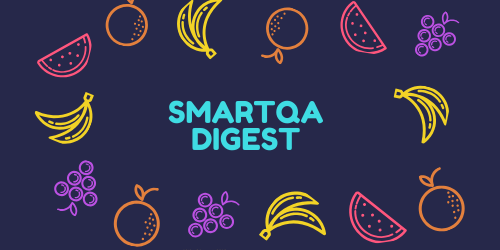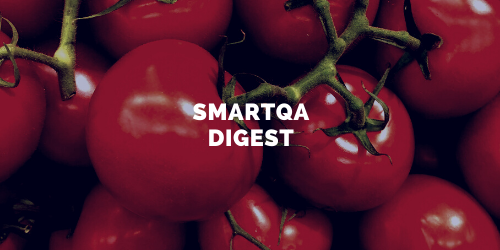features an interesting discussion with Sriramadesikan on “Expectations from enterprise customers and what it means to QA” as SmartBites video.
Continue reading#4 – On modern architecture & 50 tips
We bring you an interesting discussion with Jawahar Sabapathy on the theme “Modern system architecture and what it means to quality” as SmartBites video.
Continue readingSurviving the QA disruption- Smart testing is the way
by T Ashok
Summary
The confluence of extreme speed of business, rapid new technology adoption, cloudification & platform-ising of apps, finicky end users has created serious inflexion points, threatening the QA practice. How do we test smartly to survive & continue to grow?
Smart testing is about doing less and accomplishing more, and rapidly with razor sharp focus on business outcomes and end user experience. It is about doing what it takes to ensure great end user experience all the way, ‘extreme ownership’ as my friend called it! It is not just in the act of assessment/evaluation, it is across the entire of lifecycle of dev/test of smartly using the process, technology and tools.Technology, business, process models are evolving rapidly and disrupting the way we do things and testing too is disrupted.To survive and accomplish more in these interesting times, ‘Test smartly. Accomplish more’.
In a discussion with Sudhir Patnaik, I asked him as what the key disruptors to our discipline of testing are. His single phrase answer was “Extreme Ownership”. That it is, not just owning the act of validation, but the ownership of entire customer experience.And this he said, changes the team structure , the way we perform test, and the skills required.
Watch the full video of my discussion with Sudhir Patnaik on the theme “The changing facet of our discipline/industry”.
The ownership mindset requires a two faced tester, one adept with technology and development on one side and the other to test well. Code when required, dig deeper to understand better, shift left tests, automate as much as possible and test intelligently.
The confluence of extreme speed that business demands today, the rapid adoption of new technologies, the cloud-ification and platform-ising of applications and the finicky end users have created serious inflexion points. It is threatening the test/QA practice, what do we do now? The demands that we have on how we need to complement dev, expand our base of skills, deal with far more imprecise information and embrace technology to get work done implies a far greater reliance on our intellect. To survive this QA disruption, ‘Smart testing’ is very necessary. So, what we do ‘smartly’ across the lifecycle of dev/test?
Smart understanding
Being able to appreciate the intended customer experience implies a smarter approach to understanding the larger context, figuring out what is expected rather that ‘what is there’ to be validated. It is about figuring out how the sum total of various entities of a system contribute to the wholesome end user experience, beyond the typical piece meal validation of an entity. ‘Smart Understanding’ is an essential ingredient here. Understanding that is multidimensional, of business, end users, environment, context of usage, architecture and deployment, the technology stack and its nuances.
Smart strategy/plan
How much do we test? How much do we test earlier (Shift Left)? How much can be done statically using software tools on SmartChecklists? How much testing can be avoided? How and what do we need to do to maximally automate? How to set up a continuous health check? How much can we test under the hood? What are the ‘-ilities’ that we need to test? What is the impact of changes done? Coming up with answers to these at start and continuously refining them enables us to setup a continuous test flow that is rapid, optimal and effective.It is the sensitivity and refinement of what, how much, how early, how to test minimally, employing maximal automation. It is making appropriate choices to deliver a great customer experience continually, that demands ’Smart strategy and planning’, so that we may be continuous, responsive and effective.
Smart Design and Execution
How do you ensure that you have “potent” test scenarios/cases? That is, test scenarios/cases that are powerful enough to explore all nooks and crannies of the software to uncover issues. It is not just optimising execution via automation but using intellect and technology to ensure the net is cast wide enough and this can be done quick enough. Never underestimate that all scenarios can be designed a-priori; it is about being sensitive to the context and execution, and refine continuously. ‘Smart design’ is about being logical and use design techniques to model better, whilst at the same time be highly observant , curious and creative to come with really interesting and meaningful scenarios.
As much as good design matters, it only translates into great reality when its executed, statically or dynamically. Well as much as it sounds great to use this earlier via shift-left, it would be smarter to be sensitive and prevent. Static execution does make great sense and these can be done using software tools or thinking tools expressed as a ‘Smart Checklist’.In the case of dynamic execution to evaluate software, we have various choices : (a) under the hood automation via API (b) Front based automation of short feature thread or long business flows (c) execution by an intelligent human. Making appropriate choices using available information at the earliest and refining would be ‘Smart execution’.
Smart Documentation
Why do we document? For posterity, for future support, right? Nah, that would be old school thinking! In today’s world, documentation is to enhance one’s understanding, with the side effect of making these understanding, choices and actions available to others. Note that first reason is ‘improving one’s understanding’, to think better. So ‘Smart documentation’ is about being to-the-point (terse), staying uncluttered i.e crisp, visual as applicable with meaningful notes, and appropriate elaboration that is strictly on need basis. Given that testing today is done in short sessions, the act of documentation should never disrupt the flow of thinking, in fact it should catalyse smart thinking.
Smart Automation
Smartness is not only in doing the work oneself, it is smartly exploiting tools and technology to get this done. Automation is not limited to execution of tests to assess correctness, it is also about doing all other work in the larger context of assessment.
This could encompass test design, environment setup, data generation, problem analysis, runtime measurement, health checks, project management and deployment. In the context of assessment, ‘Smart automation’ can be (a) enabling self-test integrated into the code (b) health check suites that monitor health when change is done (c)under the hood automation using API that is more resilient (d) front end based user oriented suites (e) building frameworks that can assist the dev folks earlier to test easier (f) scripts that be easily generated and modified rapidly i.e. ‘code-less automation’ especially for UI.
Smart Analysis
When we test, we may find issues or we may not. The key is, what we do with this information.How does this help in getting a clear picture where we are and how good the system is ? How does this help make meaningful business decisions rapidly? How does this allow us to rapidly refine what we are doing? It is about sifting thorough the rich testing dataset and just showing the minimal crisp information to enable rapid decision making. This is what ‘Smart analysis’ is about. Quickly dig in deep and extract nuggets.
Smart testing is the way
Smart testing is about doing less and accomplishing more, and rapidly with razor sharp focus on business outcomes and end user experience. It is about doing what it takes to ensure great end user experience all the way, ‘extreme ownership’ as my friend called it! It is not just in the act of assessment/evaluation, it is across the entire of lifecycle of dev/test of smartly using the process, technology and tools.Technology, business, process models are evolving rapidly and disrupting the way we do things and testing too is disrupted.To survive and accomplish more in these interesting times, ‘Test smartly. Accomplish more’.
———————–
The theme of SmartQA is to explore various dimensions of smartness to leapfrog into the new age of software development, to accomplish more with less by exploiting our intellect along with technology. Towards this, we will strive to showcase interesting thoughts, expert industry views through high quality content as articles, posters, videos, surveys outlined as a SmartQA Digest weekly emailer. SmartBites is soundbites from smart people”. Ideas, thoughts and views to inspire you to think differently.
Signup to receive SmartQA digest that has something interesting weekly to becoming smarter in QA and delivering great products.
#3 – Sharpen your axe to do faster
We bring you EIGHT interesting thoughts from SIX test practitioners as SmartBites video.
Continue reading#2 – Surviving QA disrupters via smart testing
Sudhir Patnaik outlines his thoughts on today’s disrupters of QA and how we can become stronger.
Continue readingThe Buddha Story: Good understanding
by T Ashok
Good understanding is not about knowing everything in detail, it is about just knowing what is required and learning to discard what is not necessary or deferring to a later stage.
Let me tell you a beautiful Buddha story that illustrates this.
Once upon a time there lived a wise and learned man with mastery over various languages, philosophies and religions. He was extremely proud of his knowledge, but eager to learn more. He came to know that a person named Buddha lived far away and was a very learned man. Keen to further his knowledge, he went to Buddha, introduced himself as a man well versed with various philosophies, expressed his wish to enhance his knowledge and requested to teach him.
Buddha said he would be happy to do and requested him to kindly sit in the corner of the room. A few hours passed and the learned man was getting fidgety while Buddha continued to do his work. As the sun went down, Buddha suggested that they resume the next day. The learned gentleman after a good night’s rest came back promptly. Buddha again requested him sit down in the corner. The morning turned into afternoon and the dusk set in. The man was throughly upset that Buddha was ignoring him. He went up to him and said “Sir, I am very upset that you are ignoring me, I hope you understand that I am also a man of knowledge”.
Buddha calmly said “Come my dear friend, sit down let us have a cup of tea”. He took the tea pot and poured the tea onto the cup while watching the man. The cup filled to the brim and Buddha continued pouring, spilling the tea on the floor. The man watching this shouted “The cup is full, please stop pouring!”.
Buddha fully aware of what he was doing said “My friend, your mind is like this, filled with knowledge, with no space to acquire additional knowledge. Empty it and you will be ready to learn.” And only then did the learned man realise his folly.
As a test practitioner, understanding a complex system is always always interesting. The big challenge that I face is when passionate folks explain the system sparing no detail. That is when I say “STOP, I do not need to know this, will certainly ask when I need it”.Good understanding requires that the tea cup be only partially full.
Defer what is not needed now to later. Don’t attempt to understand everything at one go.
Smart QA is about having great clarity, a result of good understanding. This occurs when you are actively questioning with an agile mind, not passively absorbing and getting weighed down. Lessen your burden and your mind is like a nimble goat climbing the mountain of complexity. At the top, view the system in totality clearly. And the issues pop out.
HBT (Hypothesis Based Testing) is based on this principle of deferment and active questioning to understand complex systems rapidly and test smartly.
About SmartQA The theme of SmartQA is to explore various dimensions of smartness to leapfrog into the new age of software development, to accomplish more with less by exploiting our intellect along with technology. Towards this, we will strive to showcase interesting thoughts, expert industry views through high quality content as articles, posters, videos, surveys outlined as a SmartQA Digest weekly emailer. SmartBites is soundbites from smart people”. Ideas, thoughts and views to inspire you to think differently.
Signup to receive SmartQA digest that has something interesting weekly to becoming smarter in QA and delivering great products.



